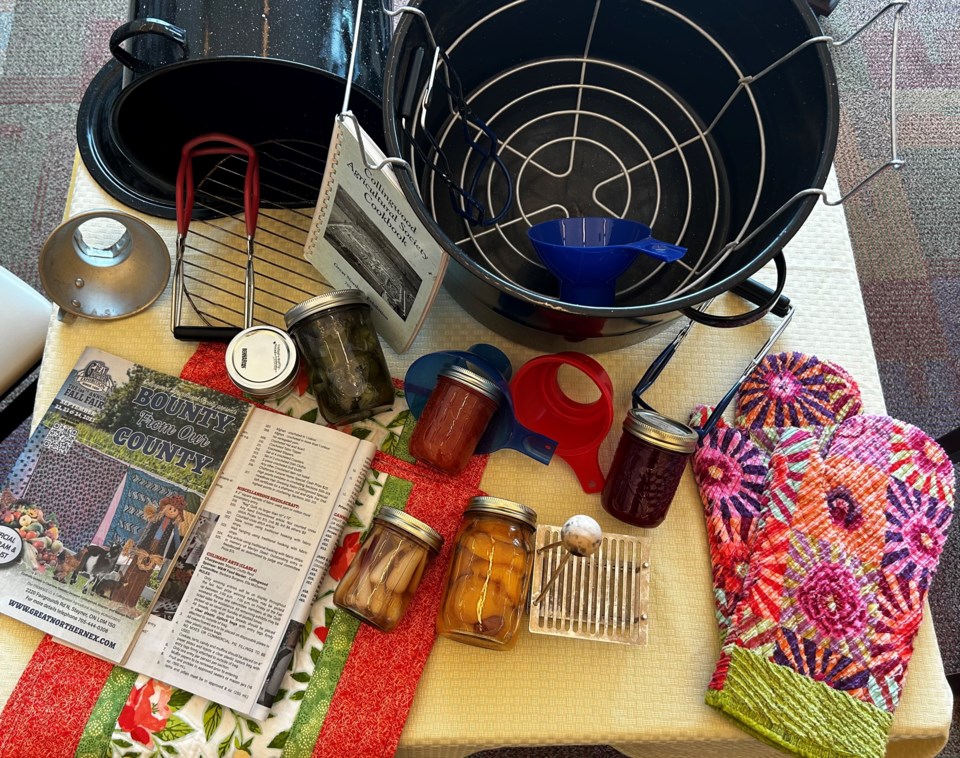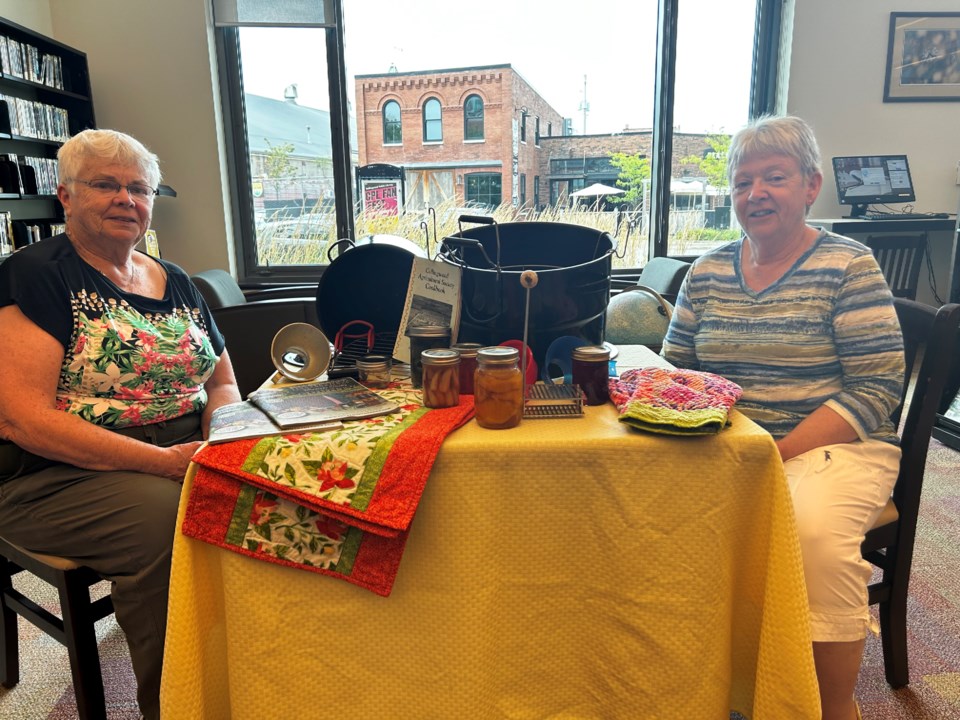Before the Brits or the Canadians ever entered the Great Bake-off tents, and before cooks aspired to the title of Iron Chef, the residents of Collingwood’s rural outskirts were pitting their pickles, peaches and pies against each other.
Canning and confection competitions began at county fairs, and the custom continues today with locals keeping the culinary traditions alive, and the bragging rights in high honour.
At the Great Northern Exhibition (GNE), Collingwood’s fair, in the culinary arts exhibits, you’ll find pickled beets, strawberry jam, apple pie and butter tarts – all have been part of the program since the fair began in 1855, 168 years ago.
Both Maxine Coutts-Reid, of Stayner, and Maureen McLeod, formerly of Glen Huron and now a Collingwood resident, are GNE culinary arts staples, exhibitors, winners, and volunteers.
McLeod started baking for the fair in 1965, after she got married, as a way to measure her pastries, breads, and treats against others.
“There’s a competitive thread to all of this,” said McLeod. “One has to prove one’s worthwhile as compared to the next farmer lady down the road or across the road.”
McLeod and her two neighbours on the Eighth Line in Nottawasaga, Bessie and Betty, often traded the first-place ribbon from year to year.
“It would be Betty, Bessie or me and we would switch who got first, second and third in a lot of the baking classes,” said McLeod.
The three were GNE-famous for their winning treats.
At one fair, McLeod’s uncle approached the three baking champs to ask why “the three women who are the best cooks in the township had the three skinniest husbands in town.”
McLeod, who worked as a registered nurse for 38 years at Sunset Manor, later folded her talents into volunteering at the fair, serving as president of the GNE host organization, the Collingwood Agricultural Society, and helping to run the exhibits. Since the days leading up to the fair became too busy to fit in baking, she put that on the shelf and drew from her preserves – many of which she grew on her farm – to stay in the competition.
She’s known for a unique peach-banana-cherry jam. The recipe is from from a late friend, who served the jam on homemade biscuits – a treat that’s baked into McLeod’s memory. The jam is reserved as a special treat, usually if someone needs a bit of extra comforting.

Coutts-Reid’s fair work is much the same, having served as president in 2004, frequently exhibiting in the baking, canning and home craft categories, and now serving as the chair of the culinary arts exhibits. She’s also a former Sunset Manor employee, where she was food supervisor for the long-term care home.
“Food’s my thing,” laughed Coutts-Reid.
She started learning canning and baking by helping her mom in the kitchen, then more in 4-H club.
Coutts-Reid has an early fall birthday, and her mom always bought a birthday cake from a local fall fair. In those days there were often categories for decorated cakes.
“The only thing about them was they always had a piece out of them because of the judges’ taste test,” she said with a laugh. “That was just lucky for me.”
Both McLeod and Coutts-Reid remember learning to can tomatoes at 4-H club meetings, and both still have the recipe books and food safety manuals they received at those youth meetings.
Their training came during a time when it wasn’t so convenient to run to the grocery store every day. Both continue to keep a bookshelf full of canned goods they prepare in their kitchen with produce purchased from neighbours.
“It’s kind of nice to have your own goods,” said Coutts-Reid, who keeps peaches and pears on hand for guests who come to dinner.
“And the thing is, you know what’s in them,” said McLeod, who has introduced her fellow picklers to the flavour provided by cassia buds – dried unopened flowers from the cassia (cinnamon) tree. She uses them in her nine-day pickles.
With more than 200 entries in the culinary arts exhibits, McLeod and Coutts-Reid said canning is one of the largest displays at the GNE.
“It’s a thing that’s fading, and that’s unfortunate,” said McLeod. “Most women don’t have the time for it now.”
But even if canning isn’t as popular as it once was, Coutts-Reid said there’s value in knowing how to do it.
“For survival … to understand your food, and how to make safe food,” said Coutts-Reid. “It rides over into what you’re buying at the store. Do you know what a bulging can means? It’s the same essentials. And it can be economical, especially if you have a garden.”
There’s also opportunity for some unique, even gourmet, food preparation when one knows how to preserve. For example, Coutts-Reid has a batch of wild leeks (ramps) pickled and saved on her canning shelf. She foraged the ramps locally, which has been a long-time tradition. The location of wild leek sources have been guarded as closely as secret fishing holes.
Canning can also prevent food waste, saving produce from rotting and using up “imperfect” produce or overripe tomatoes and berries.
Though the cans on the shelf at home can have some odd-shaped pickles, a few rust spots on the screw band portion of the lids, and chili sauce that is darker than it should be, the cans they send to the fair do aim for perfection.
“It’s a showmanship thing,” said Coutts-Reid. “We eat with our eyes … and the first thing a judge will usually do is look them over.”
Is the jelly clear? Does the jam have the right consistency? Are all the pickles the same size? Are those ramps all heads up?
There are also detailed instructions for how each culinary class is to be exhibited. Some cookies have to be two inches in diameter, jams must be in 250 ml mason jars with new lids and screw bands. The rules are held in high regard to make sure the competition is fair.
The judges are trained and authorized through the Ontario Association of Agricultural Societies, and they are limited two-year terms in order to keep fresh eyes awarding the prizes.
“Read the rules, and make sure your recipe coordinates with what they’re asking for, and try to do everything as clean and tidy as you can,” said McLeod, offering advice to anyone hoping to exhibit at this year's fair.
There are 53 categories in the culinary arts section of the GNE, including canning, baking and brewing. They’re open to anyone interested, and registration can be done in advance online at greatnorthernex.com. There are almost 2,000 categories of exhibits at the fair in total open to people of all ages and abilities.
This year’s GNE theme is Bounty from our County, and the fair runs Sept. 22-24 at 2220 Fairgrounds Rd. N in Stayner. This will be the 166th annual GNE fall fair.



